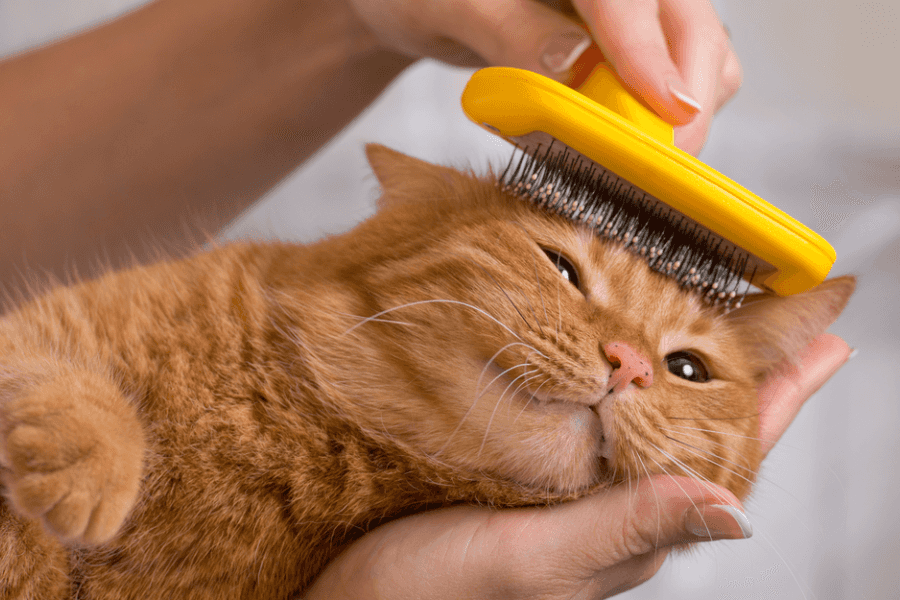How Often Should I Brush My Cat? 6 Things To Consider

Cats are known for being fastidious groomers. Their sandpaper-like tongues and unique teeth allow them to keep their coats in tip-top shape.
But even the most diligent feline groomer needs a helping hand now and then. ![]()
So how often should you brush your cat? The answer depends on several factors:
Coat length - Long-haired cats need more frequent brushing than short-haired cats.
Shedding - Increase brushing during seasonal shedding periods.
Matting - Long-haired cats prone to matting need daily brushing.
Age - Older cats may need help grooming hard-to-reach areas.
Overall health - Ill or obese cats may struggle with self-grooming.
Temperament - Nervous cats may only tolerate short, gentle grooming sessions.
Regular brushing, even for short-haired cats, provides essential skin and coat care. It removes loose hair, distributes natural oils, and gives you a chance to inspect for fleas, ticks, and skin problems. :mag:
In this post, we’ll explore the benefits of brushing your cat and provide tips on choosing the right brush, grooming technique, and optimal frequency based on your cat’s needs. Let’s dive in!
Why Is Brushing Important for Cats?

Cats spend up to 50% of their waking hours self-grooming, so why bother brushing them at all? Isn’t that what their barbed tongues are for?
While cats excel at keeping themselves clean, brushing provides benefits they can’t get from licking alone:
1. Reduces Hairballs
When a cat grooms, loose hair is swallowed. Over time, this builds up into hairballs - hard masses of undigested hair. Vomiting up hairballs is unpleasant for cats, and cleaning up the aftermath is no fun either!
Regular brushing removes shed hair trapped in the coat, reducing the amount swallowed and subsequent hairballs.
2. Prevents Matting
Matts and tangles happen when loose undercoat hair becomes trapped in the outer coat. This painful pulling on the skin can limit mobility.
Daily brushing smooths the coat, working out tangles and preventing painful mats from forming.
3. Removes Dirt and Debris
Outdoor cats can get all kinds of sticky, muddy gunk tangled in their fur. Brushing removes embedded dirt, keeping your cat’s coat clean and healthy.
4. Distributes Natural Oils
Brushing spreads sebum - the skin’s natural oils - along the hair shaft. This gives the coat a healthy shine and protects against dry, flaky skin.
5. Reduces Shedding
Regular brushing removes excess loose hair from the coat before it has a chance to shed all over your home. A quick daily brushing can significantly cut down on lint rollers and vacuum cleanings.
6. Monitoring Health
While brushing, you can inspect for signs of skin irritation, parasites like fleas and ticks, wounds, and suspicious lumps/bumps. Grooming provides an opportunity to spot potential health issues early.
Regular brushing is an essential part of cat care, providing major skin, coat, and health benefits beyond what kitty can manage alone.
How to Choose the Right Cat Brush

With so many types of cat brushes on the market, it can be tricky to choose the right one. Here are some tips:
For Short-Haired Cats: A slicker brush with fine, wire pins is ideal for short coats. The pins reach down to remove loose undercoat. Avoid using brushes with stiff plastic bristles, as these can scratch the skin.
For Long-Haired Cats: Choose a brush with widely spaced, metal tines to detangle long fur and prevent matting, like a rake comb or dematting tool. Use pin and slicker brushes to smooth the topcoat.
For Matted Fur: Dematting tools safely work out knots and tangles without pulling on the skin. Never use scissors to cut out mats - it’s too risky.
For Fleas: A flea comb has tightly spaced teeth to remove fleas and eggs while combing.
For Sensitive Skin: Try a brush with soft, flexible rubber bristles if wire pins cause irritation. Or use a grooming glove for a smoother feel.
For Shedding: Dual-sided brushes feature both stiff bristles to penetrate the coat and flexible pins to smooth the top layer. Great for heavy shedders!
Choose brushes suited to your cat’s coat length, sensitivity, and any problem areas needing special attention. Ask your vet or groomer for personalized recommendations. :speech_balloon:
How Often Should You Brush a Long-Haired Cat?

That gorgeous, flowing fur requires maintenance! Without daily brushing, long-haired cats are prone to painful matting and tangling.
Brush long-haired cats at least once per day. Work out any tangles gently using a wide-toothed comb. Then use a slicker brush or fine comb to remove loose hair and smooth the coat.
Pay extra attention to areas prone to matting like the ears, legs, belly, and tail. And be on matting patrol when your long-hair goes through shedding season, brushing 1-2 times per day.
Between professional grooming appointments, daily at-home brushing sessions are essential for keeping your long-haired cat’s coat silky and free of knots.
How Often Should You Brush a Short-Haired Cat?

With their low-maintenance coats, short-haired cats are efficient self-groomers. But they still benefit from the occasional brushing.
For short-haired cats, aim to brush at least once per week. This helps remove loose hair, distribute skin oils, and tidy up their overall look.
Short grooming sessions are usually enough to keep their coat in good shape. Increase brushing to 2-3 times per week during shedding season to control all that extra fluff.
Some short-hairs enjoy daily brushing as relaxing bonding time with their owners. But take care not to overbrush, as this can irritate the skin.
How Often Should You Brush a Kitten?

It’s important to get kittens used to brushing while they’re young. Start by gently introducing them to the brush and giving treats/praise as positive reinforcement.
For short-haired kittens: Brush once per week as part of regular grooming routine.
For long-haired kittens: Brush daily to prevent matting. Work up gradually from short, gentle sessions.
Since kittens shed less than adults, increase brushing frequency during seasonal shedding periods. The goal is to keep their coat free of tangles without over-doing it.
Regular brushing while a kitten sets the foundation for stress-free grooming throughout their lifetime.
Brushing Tips
To make brushing pleasant for you and your cat:
Use treats: Give treats during/after brushing so your cat associates it with positive things.
Keep sessions short: Start with just a few minutes until your cat is comfortable.
Use a soft touch: Avoid pulling on tangles. Work them out slowly and gently.
Check body language: Stop if your cat seems distressed.
Try different brushes: Your cat may tolerate certain brushes better.
Brush with the coat growth: Going against the coat growth can irritate skin.
Focus on problem areas: Pay extra attention to mat-prone areas.
Inspect skin: Note any irregularities to have your vet examine.
Finish with pets: Give your kitty some quality cuddle time after brushing.
With the right brush, technique, and consistent schedule suited to your cat’s needs, brushing can be beneficial bonding time instead of a battle! :smile_cat:
Conclusion

Regular at-home brushing complements your cat’s natural grooming habits. Aim for daily grooming for long-haired cats prone to matting, 1-2 times per week for short-haired cats, and establish a brushing routine for kittens early on.
Enjoy this special caring time with your feline companion!
Tags
Share
Related Posts
Quick Links

